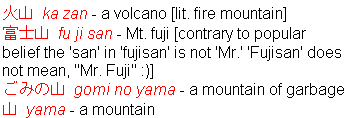| The Kanji |
Readings & Meanings |
 |
1) san,
2) yama
- mountain
Think of it as a
range of 3 mountains, the tallest being in the
center
|
 |
|
 |
1) sen,
2) kawa - a river, stream
This is a picture of water
flowing down a stream
|
 |
|
 |
1) haku,
2) byaku, 3) shira, 4) shiro(i) - white
Don't confuse this
with (自) which means self: white has one
line and (自) has two lines
|
 |
|
 |
1) ten, 2) ama, 3) ame
- heaven, the sky
Heaven is very BIGGER
than the kanji for big (大), therefore there
is a line above it
|
 |
|
 |
1) u,
2) ama, 3) ame - rain
Think of the top part
as the sky opening to release the rain
|
 |
|
 |
1) den - electricity, electric powered
Notice the top part
is rain, so think of electric lightning
|
 |
|
 |
1) ki, 2) ke, 3) iki -
spirit, intention, mind, power, energy [just look
at the examples, this kanji has many meanings]
This is a fun kanji
to draw. Sometimes the best way to learn to read
a kanji is by drawing it many times
|
 |
|
 |
1) sha,
2) kuruma - car, vehicle
Using your
imagination (to the limits of your ability), you
may see a car with 4 wheels
|
 |
|
 |
1) koku,
2) kuni - country, a nation
This is a combination
of kuchi (口) [mouth] & tama
(玉) [ball].
Sometimes if the parts that make a kanji are
strange it becomes actually easier to remember!
So get a ball stick it in your mouth
and think of your country!
|
 |
|
 |
1) en, 2) maru(i) - a
circle, yen (money
This is often used
instead of the Yen symbol ¥
|
 |
|
 |
1) wa,
2) hanashi, 3) hana(su) - a
talk, a topic, a story
Most kanji are made
of parts. The left side means 'a word' and the
right side means 'tongue'
|
 |
|
 |
1) bun,
2) ki(ku) - to hear, listen, ask
This is a combination
of gate (門) and ear (耳). People go to the gate
to hear news
|
 |
|
 |
1) jiki,
2) shoku, 3) ku(u) 4) ta(beru) - eating, a meal,
food
It looks like a
person reclining under his roof eating something
|
 |
|
 |
1) doku,
2) yo(mu) - to read
The left part means
'a word' and the right part means 'to sell.' So a
book is a bought word
|
 |
|
 |
1) rai,
2) ku(ru) - to come
This is one of the very
few irregular verbs: kuru
becomes 'kimasu' in the -masu form!
|
 |
|
 |
1) sho,
2) ka(ku) - book, document
Remember this one as
the one with a lot of horizontal lines. Also
remember there is a sun at the bottom; after all,
you must have light to read!
|
 |
|
 |
1) ken,
2) mi(ru) - to see, 3) mi(seru) -
to show
The top part is me
(eye) and think of the bottom as legs. Therefore
actively using your eyes means to see
|
 |
|
 |
1) gyou,
2) kou, 3) i(ku) - to go
It looks like a side
view of a dog (with no tail) ready to go
|
 |
|
 |
1) shutsu,
2) da(su), 3) de(ru) - to go out, leave
This looks like a
mountain on a mountain [actually it is not] So
think of going out to the
mountains
|
 |
|
 |
1) nyuu,
2) i(ru), 3) hai(ru) - enter, to go in,
to insert
It looks very much
like the kanji for a person (人) but with a little
hat on.
|
 |
|
![]() All the Kanji on the Level 4
Test: #4
All the Kanji on the Level 4
Test: #4 ![]()
![]() Print this page! | Printer friendly version | TAKE A TEST ON THESE KANJI choose KANJI 4
Print this page! | Printer friendly version | TAKE A TEST ON THESE KANJI choose KANJI 4